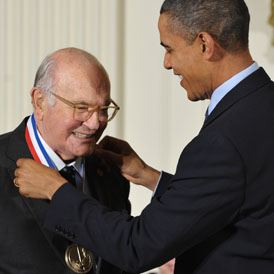Super Glue and scientific serendipity
Harry Coover, the man who invented Super Glue entirely by accident, has died. Channel 4 News looks back at other great inventions – from Post-its to Viagra – stumbled upon by chance.

Dr Harry Coover Jr – who has died aged 94 – has more than 400 patents to his name but will always be best known for stumbling across the obscure adhesive Cyanoacrylate 68 years ago, recognising its potential, and bringing the world Super Glue.
Since then it has been used to strengthen bridges, patch together the internal organs of wounded soldiers in Vietnam, and even to repair the engine of the space shuttle Discovery. In its purest form the stuff can withstand a ton of pressure on a one-square-inch bond, and it was discovered entirely by chance.
In the face of such strong evidence, it’s clear that serendipity is a crucial part of the research and creative processes of any inventor. Matthew Cain, Culture Editor
In 1942 it was found during a search for materials to make clear plastic gun sights, but it was rejected because it was too sticky. Ten years later a researcher named Fred Joyner, who was working with Dr Coover at Eastman Kodak’s laboratory in Tennessee, was looking for a temperature-resistant coating for jet cockpits.
When he spread a compound between two lenses they became permanently bonded together. Joyner’s initial reaction was panic at the loss of expensive lab equipment. But Dr Coover recognised the potential in the sticky adhesive, namely that it required no heat or pressure to bond, and so Super Glue was born.
A recent history of sticky situations
June 1996 six firefighters, two doctors and two police officers spend five hours trying to free Gary Foxley from a toilet covered in Super Glue in Macdonalds in Knightsbridge
September 1998: An unnamed elderly Peruvian is reported to have starved to death after he accidentally glued his teeth together
Nov. 2005: Pittsburgh man Kenneth Slaby sues former lover for "battery, assault, and intentional infliction of emotional distress" resulting from his buttocks being fused together.
November 2006: Merseyside father Gordon Cook superglues his own front teeth back together after claiming he couldn't find an NHS dentist.
June 2008: Campaigner Dan Glass tries to super-glue himself to Gordon Brown as a protest against the third runway at Heathrow.
And it wasn’t just Super Glue that was invented by accident. We wouldn’t have Post-it notes, penicillin, or microwaves if it wasn’t for moments of opportunity fortuitously seized by intrepid inventors.
It was poor house-keeping (or rather lab-keeping) that led to the great Alexander Fleming developing the groundbreaking antibiotic penicillin. He accidentally left a petri-dish of Staphylococcus bacteria open when he noticed that a mould that had made its way inside the dish had killed around the bacteria. That fungus turned out to be Penicillium which has saved millions of lives worldwide.
Though Post-it notes haven’t saved many lives, they have become invaluable to office life. In 1970 researcher Spencer Silver failed to create a strong adhesive to rival super-glue but succeeded in inventing a weak one that stuck to objects but easily lifted off. No-one knew what to do with it, but four years later, another researcher, Arthur Fry, was singing in his church choir. His bookmarks kept falling out of his hymnal and then he remembered the weak adhesive. Fry used some to coat his bookmarks and the post-it was born.
The microwave sang from the same hymn sheet of serendipity but its origins were far more dramatic. It was first used in radar systems called magnetrons during World War II to spot Nazi planes. Whilst standing in front of a magnetron, Percy Spencer noticed a chocolate bar in his pocket had melted. He quickly developed the idea and a revolution in the kitchen was made possible.
And it’s not just in the kitchen that accidental inventions have left their indelible mark. Viagra was initially studied for use in hypertension and angina pectoris treatment. The inventors found it had little effect on angina, but had a marked effect on other parts of the body.
"In the face of such strong evidence, it's clear that serendipity is a crucial part of the research and creative processes of any inventor," writes Culture Editor Matthew Cain.
"As is an ability to have a mind that's open to the potential of mistakes and accidents. And more generally, a lifestyle that isn't ruled by schedule and regimental planning but one which allows a certain amount of going with the flow and a full engagement in the spontaneity of life..."
Read Matthew's blog: Superglue demonstrates the art of the unexpected.
-
Latest news
-
As India goes to the polls in the world’s largest election – what do British-Indians think?6m

-
Tees Valley: Meet the candidates in one of the biggest contests coming up in May’s local elections4m

-
Keir Starmer says public sector reform will be a struggle7m

-
Nicola Sturgeon’s husband Peter Murrell charged with embezzlement of funds from SNP1m

-
Ukraine might finally get $60billion in American weapons and assistance to defend against Russia3m

-




